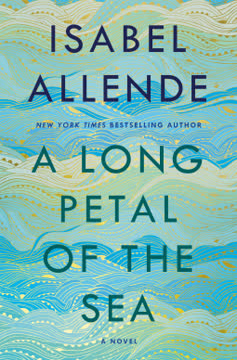Plot Summary
Lark House Sanctuary
Lark House, a quirky senior residence in the San Francisco Bay Area, is a microcosm of eccentricity, activism, and faded dreams. Here, Irina Bazili, a young Moldovan immigrant with a shadowy past, finds unexpected solace and purpose among the elderly residents. The home is a place of both refuge and reckoning, where the boundaries between past and present blur, and where the stories of its inhabitants—each carrying their own burdens—intertwine. The atmosphere is one of gentle chaos, with activism, art, and the specter of mortality ever-present. For Irina, Lark House becomes not just a workplace but a surrogate family, offering her a chance to heal and to witness the complexities of love, loss, and aging.
Irina's Haunted Past
Irina's life is marked by trauma and resilience. Raised in a poor Moldovan village by her grandparents after her mother's abandonment, she is eventually sent to America for a better life. Instead, she endures years of abuse and exploitation at the hands of her stepfather, her suffering immortalized in illicit images that haunt her adulthood. Rescued by an FBI agent, Irina reinvents herself, moving from place to place, always wary, always hiding. At Lark House, she finds a measure of stability, but her past lingers, shaping her relationships and her sense of self-worth. Her journey is one of gradual healing, as she learns to trust, to love, and to forgive herself.
Alma's Arrival and Secrets
Alma Belasco, elegant and enigmatic, arrives at Lark House, drawing attention with her aristocratic bearing and aloofness. Her presence is both magnetic and mysterious; she keeps her distance from others, save for her beloved grandson Seth and, eventually, Irina, whom she hires as a personal assistant. Alma's life is a tapestry of privilege, artistry, and sorrow, marked by a long marriage to her cousin Nathaniel and a secret, enduring love for another. Her apartment is sparse, her routines precise, and her past carefully guarded. Yet, as she ages, Alma's defenses begin to crumble, and the secrets she has kept for decades threaten to surface.
The Japanese Gardener's Son
As a child, Alma forms a deep friendship with Ichimei Fukuda, the son of the Belasco family's Japanese gardener. Their connection is immediate and profound, rooted in shared loneliness and curiosity. Together, they explore the lush gardens of Sea Cliff, finding solace in each other's company. But the world outside is less forgiving. The looming threat of war and the prejudices of society conspire to separate them, setting the stage for a love that must endure distance, silence, and the weight of history.
War, Exile, and Internment
The outbreak of World War II shatters the fragile peace of Alma and Ichimei's world. Alma's Jewish family in Poland is consumed by the Holocaust, while the Fukudas, despite being American citizens, are uprooted and sent to internment camps in the Utah desert. The trauma of exile, loss, and injustice leaves indelible scars on both families. Letters between Alma and Ichimei, censored and sporadic, become lifelines, bearing witness to suffering and resilience. The war's aftermath reshapes their destinies, forcing them to navigate a world forever altered by violence and displacement.
Forbidden Blossoms
Reunited as young adults, Alma and Ichimei's childhood friendship blossoms into a passionate, clandestine affair. Their love is intense but fraught with obstacles—race, class, family expectations, and the lingering wounds of war. They meet in secret, exchanging letters and gardenias, their relationship a fragile sanctuary from a world that would not accept them. Alma's fear of scandal and her longing for security ultimately lead her to marry Nathaniel, but her heart remains tethered to Ichimei. Their love, though often interrupted, endures across decades, sustained by memory, longing, and the written word.
Nathaniel's Devotion
Nathaniel Belasco, Alma's cousin and eventual husband, is a figure of quiet strength and selflessness. He offers Alma protection and companionship, fully aware of her enduring love for Ichimei. Their marriage is one of deep friendship rather than passion, marked by mutual respect and unspoken truths. Nathaniel's own secret—his love for another man, Lenny—mirrors Alma's hidden life, creating a bond of empathy and understanding between them. Together, they navigate the challenges of parenthood, loss, and illness, their partnership a testament to the many forms love can take.
Letters Across Decades
Throughout their lives, Alma and Ichimei sustain their connection through a series of letters—some passionate, some philosophical, all imbued with longing and hope. These missives, often hidden or disguised, become the repository of their love, a secret archive that outlives them both. The letters are not just personal; they are historical documents, bearing witness to the injustices of internment, the pain of separation, and the endurance of the human spirit. In the end, the discovery of these letters by Irina and Seth provides closure, understanding, and a bridge between generations.
The Unseen Wounds
Both Irina and Alma are shaped by wounds that are often invisible to others. Irina's abuse leaves her wary of intimacy, while Alma's losses—her family, her child, her lover—manifest as stoicism and control. The novel explores how trauma is carried, hidden, and, sometimes, transformed. Healing comes not through forgetting but through connection, storytelling, and the courage to confront the past. The characters' struggles with shame, guilt, and forgiveness are universal, resonating across time and culture.
Love in Hiding
The central love story of Alma and Ichimei is mirrored by other hidden relationships—Nathaniel and Lenny's secret romance, Irina's tentative bond with Seth, and the surrogate families formed at Lark House. The novel celebrates the resilience of love in the face of societal condemnation, the necessity of secrecy, and the bittersweet freedom found in chosen kinship. These hidden loves are both a source of pain and a wellspring of strength, challenging the boundaries of convention and redefining what it means to belong.
Loss, Guilt, and Survival
Alma's decision to marry Nathaniel and forsake a life with Ichimei is driven by fear, pragmatism, and the weight of social expectation. The consequences—miscarriage, emotional distance, and lifelong regret—haunt her, even as she builds a successful career and family. Survival, the novel suggests, often comes at a cost, and the choices made in the name of safety or propriety can leave lasting scars. Yet, through art, memory, and the act of letting go, the characters find ways to honor their losses and move forward.
The Weight of Memory
The narrative is suffused with the weight of personal and collective memory—of war, migration, prejudice, and resilience. The characters are both witnesses and survivors, their lives shaped by events beyond their control. The act of remembering—through letters, photographs, and storytelling—is both a burden and a blessing, offering the possibility of understanding, reconciliation, and legacy. The past is never truly past; it lives on in the choices, relationships, and identities of the present.
Generations and Inheritance
The story spans multiple generations, from Alma's childhood in Poland to her final days at Lark House. The Belasco and Fukuda families, though marked by tragedy, are also sources of strength and continuity. Inheritance is not just material but emotional and cultural—a transmission of stories, values, and unresolved questions. The younger characters, Irina and Seth, inherit not only the secrets of their elders but also the task of making sense of them, forging their own paths toward healing and connection.
The Final Farewell
As Alma's health declines, the themes of mortality and dignity come to the fore. Surrounded by friends and family, she confronts her own end with a mixture of fear, acceptance, and grace. The rituals of death—funerals, mourning, the distribution of possessions—are depicted with sensitivity and realism. Alma's final act is one of generosity, entrusting her letters and memories to Irina, ensuring that her story, and the love that defined it, will not be forgotten.
Truths Revealed
In the aftermath of Alma's death, Irina and Seth uncover the full extent of her relationship with Ichimei, piecing together the hidden narrative through letters and memories. The revelation is both shocking and liberating, allowing them to understand the complexities of love, loyalty, and sacrifice. The process of uncovering the truth is itself an act of healing, bridging the gaps between generations and offering a measure of closure to the living and the dead.
The Power of Forgiveness
Forgiveness—of oneself and others—is a central theme. Irina learns to forgive herself for her past, Alma comes to terms with her choices, and the characters extend compassion to those who have hurt them, intentionally or not. The novel suggests that forgiveness is not a single act but an ongoing process, one that requires vulnerability, honesty, and the willingness to embrace imperfection. Through forgiveness, the characters reclaim their agency and find the courage to love again.
Endings and Beginnings
The story concludes with a sense of continuity and renewal. Alma's death is not an ending but a transition, her legacy living on in the lives she touched and the stories she left behind. Irina and Seth, having confronted their own fears and inherited traumas, are poised to begin anew, their relationship a testament to the possibility of healing and hope. The novel closes on a note of quiet optimism, affirming the enduring power of love, memory, and human connection.
Characters
Alma Belasco
Alma is the novel's central figure—a Polish Jewish refugee, artist, and matriarch whose life is shaped by exile, loss, and a forbidden love. Sent to America as a child to escape the Holocaust, she is haunted by the fate of her family and the trauma of displacement. Her lifelong affair with Ichimei Fukuda, the Japanese gardener's son, is both her greatest joy and deepest sorrow, conducted in secrecy due to societal prejudice. Alma's marriage to Nathaniel is one of friendship and mutual support, but her heart remains with Ichimei. As she ages, Alma becomes both more vulnerable and more open, entrusting her story to Irina and Seth. Her journey is one of self-discovery, regret, and, ultimately, acceptance.
Ichimei Fukuda
Ichimei is the son of Japanese immigrants, a gifted gardener and artist whose life is upended by wartime internment. Sensitive, disciplined, and deeply spiritual, he forms a bond with Alma that transcends race, class, and circumstance. Their love, though often thwarted, is sustained by letters, memory, and fleeting encounters. Ichimei's experiences of prejudice and loss shape his worldview, making him both cautious and compassionate. His relationship with Alma is marked by tenderness, longing, and the quiet heroism of loving in secret. He is a symbol of resilience and the enduring power of the heart.
Irina Bazili
Irina is a young Moldovan immigrant whose traumatic past has left her wary and self-effacing. At Lark House, she finds a sense of purpose and community, forming close bonds with Alma and Seth. Her journey is one of gradual healing, as she confronts her history of abuse and learns to trust again. Irina's empathy and resilience make her both a caregiver and a catalyst for change, helping others while seeking her own redemption. Her relationship with Seth offers the possibility of love and renewal, though it is fraught with the challenges of overcoming trauma.
Nathaniel Belasco
Nathaniel is Alma's cousin, husband, and lifelong confidant. His devotion to Alma is unwavering, even as he grapples with his own secret—his love for Lenny, a relationship made impossible by the prejudices of the time. Nathaniel's marriage to Alma is one of deep friendship and mutual support, marked by honesty and sacrifice. His struggle with illness and mortality is depicted with sensitivity, and his acceptance of Alma's love for Ichimei is both generous and tragic. Nathaniel embodies the complexities of love, loyalty, and the costs of living inauthentically.
Seth Belasco
Seth is Alma's grandson, a lawyer and aspiring writer who becomes obsessed with uncovering his grandmother's secrets. His relationship with Irina is marked by patience, humor, and a desire to protect. Seth serves as a bridge between generations, piecing together the hidden narratives of his family and seeking to understand the forces that shaped them. His journey is one of maturation, empathy, and the search for meaning in the stories of the past.
Lenny Beal
Lenny is a charismatic, openly gay man who becomes both Alma's confidant and Nathaniel's lover. His presence at Lark House brings joy and companionship to Alma's final years. Lenny's own struggles with illness and mortality mirror those of the other characters, and his friendship with Alma is a testament to the power of chosen family. His relationship with Nathaniel, though secret, is deeply significant, offering both men a measure of happiness in a world that would not accept them.
Catherine Hope
Cathy is a doctor and resident at Lark House, paralyzed after a climbing accident. She becomes a mentor and friend to Irina, offering wisdom, humor, and practical support. Cathy's pain clinic is a haven for the suffering, and her philosophy of living in the present and embracing happiness is a guiding force for the other characters. Her resilience and kindness make her a beloved figure in the community.
Takao and Heideko Fukuda
Ichimei's parents, Takao and Heideko, are first-generation Japanese immigrants whose lives are marked by hard work, cultural pride, and the trauma of internment. Takao's spiritual beliefs and Heideko's pragmatism shape their family's response to adversity. Their experiences reflect the broader history of Japanese Americans during World War II, and their legacy is carried forward by their children.
Megumi Fukuda
Ichimei's sister, Megumi, is a strong-willed, intelligent woman who becomes a nurse and marries Boyd, a white American. Her story highlights the challenges of interracial relationships and the complexities of identity. Megumi's resilience and adaptability make her a vital support for her family, and her journey mirrors the broader struggles of Japanese Americans in the postwar era.
Delphine Fukuda
Delphine is Ichimei's wife, a Japanese American woman who manages the family nursery and raises their children. Though her marriage to Ichimei is marked by his enduring love for Alma, Delphine is portrayed with dignity and strength. Her presence is a reminder of the sacrifices made by those who love in the shadow of another's passion.
Plot Devices
Nonlinear Narrative and Multiple Perspectives
The novel employs a nonlinear structure, shifting between past and present, and among the perspectives of Alma, Irina, Seth, and others. This mosaic approach allows the gradual revelation of secrets, the layering of personal and historical trauma, and the interplay between memory and reality. The use of letters, photographs, and oral histories as narrative devices deepens the sense of intimacy and authenticity, while also highlighting the unreliability of memory and the subjectivity of truth.
Letters as Emotional Anchors
Letters between Alma and Ichimei serve as both plot device and emotional core, bridging time and distance, and preserving a love that cannot be lived openly. The discovery of these letters by Irina and Seth after Alma's death provides the novel's climax, offering resolution and understanding. The letters also function as historical documents, bearing witness to the injustices of internment and the endurance of the human spirit.
Secrets, Silence, and Revelation
The motif of secrecy—whether personal, familial, or societal—runs throughout the novel. Characters conceal their true selves, their traumas, and their desires, often out of fear or necessity. The gradual unveiling of these secrets, through investigation, confession, and discovery, propels the narrative and catalyzes transformation. The tension between what is hidden and what is revealed underscores the novel's exploration of identity, shame, and the longing for acceptance.
Intergenerational Trauma and Healing
The novel explores how trauma—whether from war, abuse, or prejudice—is transmitted across generations, shaping relationships and self-perception. Healing is depicted as a communal process, requiring empathy, storytelling, and the courage to confront pain. The characters' journeys toward forgiveness and self-acceptance are mirrored in the broader historical context, suggesting that personal and collective wounds are intertwined.
Symbolism of Gardens and Flowers
Gardens, flowers, and the act of cultivation recur as symbols of beauty, fragility, and endurance. The cherry blossoms of Alma and Ichimei's childhood, the gardenias sent in secret, and the act of gardening itself all serve as metaphors for the characters' relationships—ephemeral yet persistent, vulnerable yet capable of renewal. Nature becomes a space of refuge, memory, and connection, transcending the boundaries imposed by society.
Analysis
Isabel Allende's The Japanese Lover is a sweeping meditation on love, loss, and the enduring impact of history on individual lives. Through the intertwined stories of Alma, Ichimei, Irina, and their families, the novel explores the ways in which trauma—whether from war, prejudice, or personal violation—shapes identity and relationships across generations. Allende deftly weaves together themes of forbidden love, the search for belonging, and the necessity of forgiveness, using nonlinear storytelling and epistolary devices to reveal the hidden depths of her characters. The novel is both a critique of societal intolerance and a celebration of resilience, suggesting that healing is possible through empathy, storytelling, and the courage to embrace one's truth. Ultimately, The Japanese Lover affirms the power of love—not just romantic, but familial and communal—to transcend time, suffering, and even death, leaving a legacy of hope for those who come after.
Last updated:
FAQ
0. Synopsis & Basic Details
What is The Japanese Lover about?
- A sweeping saga of forbidden love: The Japanese Lover tells the story of Alma Belasco, a Polish-Jewish émigré who finds refuge in San Francisco during World War II, and her lifelong, clandestine love affair with Ichimei Fukuda, the son of her family's Japanese gardener. Their bond defies societal prejudices of race and class, enduring through decades of separation, war, and personal sacrifice.
- Intergenerational secrets and healing: The narrative unfolds through the eyes of Irina Bazili, a young Moldovan caregiver at Lark House, the eccentric senior residence where Alma spends her final years. Irina, along with Alma's grandson Seth, embarks on a journey to uncover Alma's hidden past, inadvertently confronting her own deep-seated traumas and finding a path toward healing and connection.
- The enduring power of memory: At its core, the novel explores how personal and collective memories shape identity and destiny. It delves into the historical injustices of the Holocaust and the Japanese American internment, illustrating how these events leave indelible marks on individuals and families, and how love and resilience can blossom even in the face of profound loss.
Why should I read The Japanese Lover?
- Rich historical tapestry: Readers seeking a deeply immersive historical fiction experience will appreciate Isabel Allende's meticulous portrayal of WWII-era San Francisco, the Japanese internment camps, and the lingering shadows of the Holocaust. The novel offers a poignant look at how global conflicts impact individual lives and forbidden loves.
- Complex character studies: The book features a cast of unforgettable characters, particularly Alma Belasco, whose blend of aristocratic poise and hidden vulnerability makes her a compelling protagonist. Her journey, alongside Irina's path to overcoming trauma, offers profound insights into human resilience, sacrifice, and the many forms love can take.
- Allende's signature lyrical prose: Fans of Isabel Allende's distinctive writing style will find her characteristic blend of magical realism, vivid imagery, and emotional depth. The narrative is beautifully crafted, weaving together multiple timelines and perspectives to create a captivating and ultimately hopeful story about the enduring nature of the human spirit.
What is the background of The Japanese Lover?
- World War II and its aftermath: The novel is deeply rooted in the historical context of World War II, specifically the Holocaust in Europe, which forces Alma's family to send her to America, and the Japanese American internment in the United States, which separates Ichimei from his family and Alma. These events are not just backdrops but central forces shaping the characters' lives and choices.
- Mid-20th Century American social prejudices: The story highlights the pervasive racial and social prejudices of the era, particularly against Japanese Americans, which made Alma and Ichimei's love "forbidden." It also subtly touches upon the stigma surrounding homosexuality, as seen in Nathaniel's hidden life and later the AIDS epidemic, providing a nuanced look at societal intolerance.
- Cultural and philosophical influences: The narrative incorporates elements of Japanese culture, such as the Oomoto religion and martial arts, through the Fukuda family, contrasting them with American individualism. Alma's artistic journey, inspired by figures like Vera Neumann, and her later "penance" at Lark House, reflect broader themes of self-discovery and the search for meaning in a complex world.
What are the most memorable quotes in The Japanese Lover?
- "Pause, shadow of my elusive love, image of my most dear enchanter, Beautiful illusion for whom I die gladly Sweet fiction for whom I live sadly.": This epigraph by Sor Juana Inés de la Cruz perfectly encapsulates Alma's lifelong, bittersweet love for Ichimei, a "sweet fiction" that sustains her even as reality forces her into a "sad" conventional life. It foreshadows the enduring, almost mythical quality of their relationship.
- "Age doesn't make anyone better or wiser, but only accentuates what they have always been.": Lupita Farias's pragmatic observation offers a profound insight into human nature and the aging process. It suggests that character traits, whether positive or negative, are amplified rather than transformed by time, challenging romantic notions of wisdom in old age.
- "Hearts are big enough to contain love for more than one person.": Nathaniel Belasco's poignant confession to Alma reveals his deep understanding of her love for Ichimei, while also hinting at his own capacity for multiple loves. This quote challenges conventional monogamous ideals and underscores the novel's theme of love's expansive and complex nature.
What writing style, narrative choices, and literary techniques does Isabel Allende use?
- Lyrical and evocative prose: Allende employs a rich, sensory language that immerses the reader in the characters' emotional landscapes and the diverse settings, from the lush Sea Cliff garden to the stark Topaz internment camp. Her descriptions are often poetic, blending the mundane with the magical.
- Nonlinear, multi-perspective storytelling: The narrative skillfully jumps between different time periods and points of view, primarily Alma's past and Irina and Seth's present investigation. This mosaic structure allows for a gradual unveiling of secrets, building suspense and revealing the intricate connections between seemingly disparate events and characters.
- Symbolism and foreshadowing: Allende masterfully uses recurring symbols, such as gardens, flowers (especially gardenias), letters, and even cats, to deepen thematic meaning. Subtle foreshadowing, like Emily's ghost or Lenny's illness, adds layers of anticipation and emotional resonance, enriching the reader's interpretive experience.
1. Hidden Details & Subtle Connections
What are some minor details that add significant meaning?
- Alma's "toy car" and its symbolic purpose: Alma's lime-green Smart car, which she chose because its "garish color made it visible for other drivers, and its small size meant that if by some misfortune she ran someone over, she would most likely not kill them," subtly reveals her underlying desire for control and minimal harm, even in her recklessness. This detail highlights her pragmatic approach to life and her awareness of her own aging body, contrasting with her earlier, more impulsive nature.
- The recurring Neko cats as emotional anchors: Alma's succession of cats, all named Neko (Japanese for "cat"), serves as a poignant symbol of her need for consistent, non-judgmental companionship throughout her life. The detail of Neko being her "confidant for eighteen years" and her difficulty sleeping without his weight underscores Alma's deep-seated loneliness and her preference for the uncomplicated affection of animals over human intimacy, especially given her guarded nature.
- Kirsten's unexpected role as keeper of secrets: Kirsten, Alma's assistant with Down syndrome, initially appears as a minor character, but her role in safeguarding Ichimei's letters in her backpack is profoundly significant. This detail highlights her unwavering loyalty and innocence, suggesting that the most precious secrets are often entrusted not to the most intelligent or powerful, but to those with the purest hearts, untouched by the complexities and judgments of the world.
What are some subtle foreshadowing and callbacks?
- Emily's ghost foreshadowing Alma's spiritual connection: The early mention of Emily, the chocolate magnate's daughter, and her son haunting Lark House, initially dismissed by Irina, subtly foreshadows the novel's later exploration of the spiritual realm and the enduring presence of the dead. This callback culminates in Irina's perception of Ichimei at Alma's deathbed, suggesting that love can transcend physical boundaries and that the spirits of loved ones remain close.
- Frenchie's inheritance setting up Irina's character arc: Jacques Devine's unexpected bequest to Irina, and her refusal to accept "ill-gotten gains," subtly foreshadows her deep moral compass and her journey towards healing from past exploitation. This early event establishes her integrity and her aversion to tainted money, which becomes crucial when she later confronts her own traumatic past and the possibility of compensation.
- The "wardrobe of sorrows" as a recurring motif of refuge: Alma's childhood habit of weeping in her "three-mirrored wardrobe" is a subtle callback to a place of hidden grief and vulnerability. This motif is echoed in Irina's own need for refuge from her nightmares and her initial guardedness, creating a thematic parallel between the two women's experiences of trauma and their search for safe spaces, both physical and emotional.
What are some unexpected character connections?
- Isaac Belasco's profound respect for Takao Fukuda: Despite the vast social and racial divide, Isaac Belasco "doffed his hat" to Takao Fukuda, the Japanese gardener, and formed a deep, respectful partnership with him. This unexpected connection highlights Isaac's progressive nature and his ability to see beyond societal prejudices, laying the groundwork for the later, more complex relationship between Alma and Ichimei. It also subtly challenges the prevailing racism of the era.
- Nathaniel's martial arts training with Ichimei: The detail that Ichimei taught Nathaniel martial arts to defend himself from school bullies creates an unexpected, early bond between the two men who would later share Alma's love. This connection, though brief, establishes a foundation of mutual respect and shared experience, making Nathaniel's later acceptance of Alma's love for Ichimei more understandable and poignant.
- Lenny Beal's connection to Nathaniel's final days: Lenny, initially introduced as Alma's friend, is revealed to have been Nathaniel's secret lover and companion during his final illness. This unexpected connection deepens the understanding of Nathaniel's character and his marriage to Alma, revealing a complex web of hidden loves and sacrifices. It also highlights the societal pressures that forced such relationships into secrecy, even within a seemingly progressive family.
Who are the most significant supporting characters?
- Lupita Farias, the grounding force of Lark House: Lupita, the head of cleaning staff, offers Irina practical wisdom and a no-nonsense perspective on life and aging. Her advice, such as "age doesn't make anyone better or wiser, but only accentuates what they have always been," provides a crucial moral compass and a sense of grounded reality amidst the eccentricities and emotional complexities of Lark House. She represents the wisdom of experience and unconditional care.
- Dr. Catherine Hope, the spiritual guide and advocate: Cathy, a wheelchair-bound doctor, becomes Irina's mentor and a beacon of resilience and compassion. Her philosophy of embracing the present moment and finding happiness, even amidst chronic pain, offers profound guidance to Irina. Cathy's role in establishing the pain clinic and her open-mindedness towards "elective death" make her a significant figure in shaping the community's approach to dignity in aging.
- Kirsten, the innocent keeper of Alma's legacy: Kirsten, Alma's assistant with Down syndrome, embodies unwavering loyalty and pure affection. Her seemingly simple presence belies her crucial role in preserving Ichimei's letters, which ultimately unravel Alma's life story. Kirsten symbolizes the power of unconditional love and the idea that profound truths can be safeguarded by those least expected, highlighting the novel's theme of hidden depths.
2. Psychological, Emotional, & Relational Analysis
What are some unspoken motivations of the characters?
- Alma's "penance" at Lark House: Alma's decision to move to Lark House, which she describes as a "penance" and a way of "paying for her life of privilege," is an unspoken motivation rooted in deep-seated guilt over her past choices, particularly her abandonment of Ichimei and her privileged life while others suffered. This act of self-imposed simplicity is her way of seeking atonement and finding a more authentic self, stripped of "ornaments and accessories."
- Nathaniel's marriage as a shield for his true self: Nathaniel's unwavering devotion to Alma and his willingness to marry her, knowing her love for Ichimei, is driven by an unspoken motivation to protect her, but also to create a conventional facade for his own hidden homosexuality. His marriage provides him with societal respectability and a cover for his secret life with Lenny, highlighting the sacrifices made to conform to societal expectations.
- Ichimei's stoicism as a form of protection: Ichimei's consistent reserve and his decision not to press Alma to marry him, despite their profound love, are motivated by an unspoken understanding of the insurmountable societal barriers they faced. His stoicism is a protective mechanism, shielding Alma from the hardships of a life with him and preserving the purity of their love in a "bubble," free from the "thorns of life."
What psychological complexities do the characters exhibit?
- Irina's trauma-induced aversion to intimacy: Irina's past abuse manifests as a profound psychological complexity: a visceral fear of physical intimacy and a tendency to "hide herself" and escape into fantasy worlds. Her journey involves confronting this deep-seated trauma, learning to trust Seth, and gradually allowing herself to experience love and touch, symbolizing the long and arduous path to psychological healing.
- Alma's blend of arrogance and profound insecurity: Alma exhibits a complex duality: an outward aristocratic bearing and "imperial dignity" that masks a deep-seated insecurity and fear of vulnerability. Her "haughty attitude was a defense against other people's curiosity," and her stoicism was a learned response to profound loss. This complexity makes her both formidable and deeply relatable, as she grapples with her past and her true self.
- Nathaniel's internal conflict between duty and desire: Nathaniel's psychological complexity lies in his lifelong struggle to reconcile his societal duties as a Belasco heir and husband with his true sexual identity. He lives a "schizophrenic" life, maintaining an "irreproachable and successful public life" while harboring a hidden, illicit love. This internal conflict highlights the immense pressure of societal expectations and the personal cost of living inauthentically.
What are the major emotional turning points?
- Alma's decision in Tijuana: The trip to Tijuana for a clandestine abortion, and Nathaniel's last-minute intervention, marks a major emotional turning point for Alma. It forces her to confront her "cowardice," her "horror of poverty," and her "shame at becoming pregnant" outside of wedlock. This moment of profound moral compromise and Nathaniel's sacrifice irrevocably alters her life path and deepens her sense of guilt, shaping her future choices.
- Nathaniel's deathbed confession to Alma: Nathaniel's revelation of his homosexuality and his love for Lenny to Alma on his deathbed is a powerful emotional turning point. It shatters years of unspoken truths and pretense, allowing for a moment of profound intimacy, understanding, and forgiveness between them. This confession liberates both characters, allowing Alma to fully grieve and Nathaniel to die authentically, surrounded by love.
- Irina's decision to reveal her past to Seth: Irina's choice to finally confide the full extent of her traumatic past to Seth, following Cathy's advice, is a crucial emotional turning point. This act of vulnerability, after years of hiding and self-reinvention, signifies
Review Summary
The Japanese Lover received mixed reviews, with some praising Allende's storytelling and character development, while others found it lacking depth compared to her earlier works. Many appreciated the historical elements and themes of love, aging, and overcoming adversity. Some readers felt emotionally disconnected from the characters, while others were deeply moved by the central love story. The novel's exploration of social issues and its portrayal of elderly characters were generally well-received. Overall, it was considered a gentle, poignant read, though not Allende's strongest work.
Download PDF
Download EPUB
.epub digital book format is ideal for reading ebooks on phones, tablets, and e-readers.












